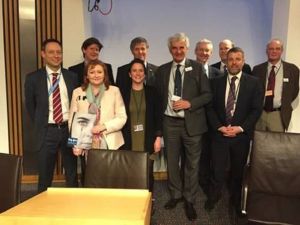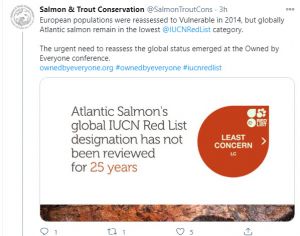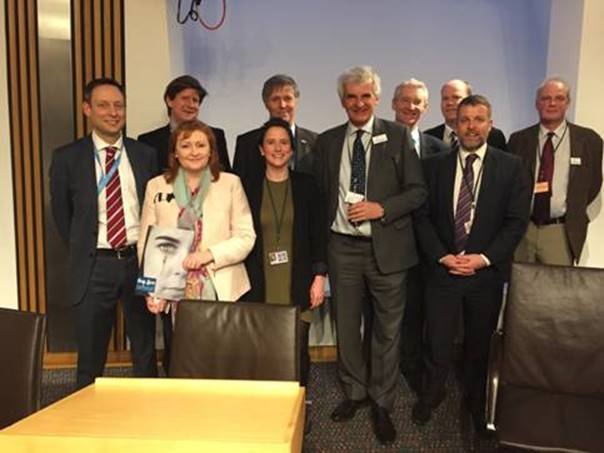NO. NO. NO: Watching the latest episode of the assault on the salmon farming industry filled me with despair. It appears to me that no-one took any notice of the most relevant points arising from the REC Committee inquiry into the salmon farming industry. Last week, the Committee met to hear how the recommendations they made in their report had progressed.
When Stewart Stevenson MSP asked the first group of witnesses whether there is an interaction that matters between farmed salmon and wild fish, Peter Pollard from SEPA in a paraphrased reply said ‘do we think that sea lice from farmed fish are responsible for the declines that we have seen over the decades in wild fish then the answer is no’.
Yet, the alleged impact of farmed salmon on wild fish stocks was the precise reason why the REC Committee chose to investigate the salmon farming industry. The inquiry was prompted by a petition submitted by Salmon & Trout Conservation that stated that (unnamed) fishery scientists are increasingly clear that sea lice on fish farms harm wild salmon. The evidence that S&TC used to support the petition was wholly circumstantial and consequently the petition should have been thrown out and this inquiry should never have taken place.
After passing through the Petitions Committee, the petition ended up with the REC Committee. They met three times to discuss the petition during 2016 and 2017, although none of these discussions exceeded six or seven paragraphs in the official report. The discussions concluded with the convener suggesting that the petition continue to an inquiry. He also declared his interest in a wild salmon fishery. He had previously declared this at the meeting of 14th December 2016, but he also had stated that ‘I have views on sea lice’.
This is not surprising since he had attended a meeting earlier that year in Holyrood organised by Salmon & Trout Conservation to promote their film about the demise of Loch Maree sea trout.

![]()
The subsequent report that was published following the inquiry in 2018 highlighted that:
“One of the key concerns expressed was that the presence of large numbers of salmon in farms attracted sea lice which, in turn, could increase infestation levels in wild salmon passing farms on their migratory routes. Indeed, it was concerns about the impact of sea lice on wild salmon raised in petition PE1598 which contributed to the Committee’s decision to undertake an aquaculture inquiry. Many of the submissions received, expressed concern about the impact farmed fish have on wild fish populations. A number of fisheries trusts and boards submitted evidence expressing considerable concern about this.”
All these concerns came from the wild fish sector yet the scientists from SAMS who were commissioned to write a scientific review of the impacts of salmon farming offered a different opinion:
“Paul Tett, one of the authors of the SRSL report, informed the Committee that— We could not find definitive evidence in Scotland that sea lice from farmed salmon are having an impact on wild salmon populations.”
Quite clearly, some MSPs recognise that salmon farming is not the cause of wild fish declines for MSP Stewart Stevenson told the meeting last week that:
“It is beyond debate that the number of wild fish has declined for a very long time, long before there was fish farming. In fact, when I worked for the Tay Salmon Fishery Board fifty-two years ago, it was a matter of concern then.”
He continued:
“I’m not assuming that there is a meaningful interaction because on the east coast we have seen as big decline as we have in the west and there are no farms on the east coast.”
My question is for how much longer do we have to endure this farce with wild fish interests continuing to blame salmon farming for the lack of fish for them to catch yet being unable to provide any hard evidence to support their claims. Salmon farming is not responsible for the decline of wild fish. If Alan Wells of Fisheries Management Scotland or Andrew Graham Stewart of Salmon & Trout Conservation are convinced otherwise, then be prepared to tell me direct to my face that I am wrong and why.
Meanwhile, SEPA’s Peter Pollard told the REC Committee that:
“the issue now is whether the state of the wild fish population at the moment can be affected by the added pressure of sea lice as the fish migrate to sea.
It’s not suggesting that the declines over the past few decades are due to salmon farming. The concern is with wild fish at such low levels whether the added pressure of sea lice is now significant.”
Mr Pollard sat on the Salmon Interaction Working Group and I would imagine that his day job means that he often gets to speak to representatives of the wild fish sector so has repeatedly heard their many claims about the impacts of salmon farming on wild fish but from where I stand it seems to me that if salmon farming is not responsible for the decline of wild fish numbers, then just because the population is at a low level, why should salmon farming now have any additional impact. Either it is responsible for the decline of wild fish or it isn’t?
The salmon farming inquiry began taking evidence on March 7th, 2018. Since then, the wild fish sector has caught and killed 879 wild fish from the area around salmon farms (not including any fish killed during 2020 because this data will not be available for another five months).
It’s interesting that a great deal of time and money is now being directed at investigating the risk that sea lice from salmon farms pose to wild fish even though it is accepted outside the wild fish sector that salmon farming is not responsible for the decline of wild fish; no-one mentions or seems to care about the fact that 879 fish (that we know about) were killed before they were able to regenerate the population.
Mr Pollard mentioned that there is a technical working group working on the issue of interactions. My understanding is that a small group from Marine Scotland Science, SEPA and Nature Scotland are modelling the spread of sea lice from salmon farms. The question is why? Clearly, if sea lice from salmon farms are not responsible for the decline of wild fish then what is the purpose of this model?
Last week, BBC TV broadcast a documentary that followed the science about COVID during the first national lockdown. The focus was very much the modelling used to help Government arrive at their decisions. Professor Gabriel Scally – a public health expert and former health advisor 2012-2015 – summed up the thinking by saying:
“I think we got ourselves into a mess (about COVID) by relying on modelling and allowing modelling to drive the whole response.”
Although they are not in any way comparable with COVID, Professor Scally’s comments are very reminiscent of what is happening in Norway with modelling dictating the response to similar claims that salmon farming is responsible for the declines there. The problem with modelling, as the COVID scientists discovered, is it is susceptible to the preconceptions of the scientists who build the models. The sea lice model currently underway clearly has an assumption that sea lice harm wild fish otherwise, there would be no point in building the model. However, as we know that salmon farming is not responsible for the decline in wild fish numbers, the model is irrelevant.
The same question should be asked of the west coast tracking project. If salmon farming has no impact on wild fish, then there is little point in spending over £750,000 to track migrating fish. The money would be better spent finding out what is causing the decline of wild fish than trying to implicate salmon farms that are clearly not to blame.
Finally, these projects are the consequence of the Salmon Interactions Working Group and I appreciate that the salmon farming industry were represented in this group, but they were very much a minority. I do have some major issues with the report but will only mention one here.
The report states:
“The SIWG recognises that there are a number of gaps in our understanding relating to wild farmed interactions. However, SIWG is firmly of the view that filling these knowledge gaps is not a pre-requisite for taking forward regulatory reform.”
My interpretation of this statement is that ‘we don’t really want to know that salmon farming is not responsible for the decline of wild fish because that would interfere in plans to impose stringent regulation on the salmon farming industry.
I’m not surprised that they did not want to accept external submissions, but this should not be expected as the wild fish sector has their narrative about salmon farming and they are going to stick with it even if they are totally wrong.
Trucking it: During the REC Committee meeting, the convener questioned the average 15% mortality of salmon during the marine phase. He said that according to data he had obtained from SEPA, the total mortality during June, July and August amounted to 8,800 tonnes of farmed salmon. This, he said, would require more than 300 articulated lorries to move and this equated to enough lorries to stack up the roads between Holyrood and Murrayfield.
On hearing this, I was less than impressed by these comments. I would have expected these from the critics like Salmon & Trout Conservation rather than coming from a MSP, let alone a committee convener. It seems more sensationalist than an actual question.
The anticipated production for 2020 as recorded in Marine Scotland’s annual statistics is 207,630 tonnes. If the mortality was 15% as discussed, then this would amount to a total of 31,145 tonnes. The convener expressed concern that the 8,800 tonnes he highlighted was too high. This figure equates to an average 2,930 tonnes per month whilst at 15% the average monthly mortality would be just 2,600 tonnes. The convener’s figures appear a little higher than the annual average but then his figures come at a time of peak summer temperatures.
The convener mentioned that he had some difficulty in understanding the figures given to him although why is unclear. The SEPA data is recorded as mortality in kg every month for 369 different sites. However, because the biomass is different on every site, this is best expressed as a percentage and is typically, less than 2%.
The SEPA spreadsheet for 2019 totals 4,428 sets of data (12 months x 369 sites) and out of this total, only 13 of these record a mortality of 20% and above. That equates to 0.3% of mortality events. A further 29 record mortality of between 10% and 19% equating to 0.65% of the total. This means that less than 1% of mortality incidents were above 10%. Unfortunately, these incidents are not the norm, but it is these figures that critics tend to use to try to undermine the industry.
These monthly figures can be totalled for each site to produce an annual figure as well as one for the whole industry. Using SEPA data, the industry had an annual mortality of 10.5% in 2018 and 12.8% in 2019, even lower than the 15% quoted in the meeting.
The discrepancy between these numbers is because the industry tends to use numbers of fish rather than biomass.
The other point is that the 15% average mortality might seem high to the convener, but they are derived from a high level of production.
As someone with interests in a wild fishery, the convener will not need reminding that mortality of returning salmon in the wild has increased from around 80% in the 1980s to about 97% now. Against this, 15% mortality should be considered an achievement.
According to the register of interests, the convener part owns a fishery on the River Spey.
![]()
Since records began, anglers on the River Spey have caught and killed 2,264 tonnes of wild fish. Using the convener’s comparison, this is enough fish to fill 75 lorries. Interestingly, this is 85% of the total catch with only 15% of the fish caught returned to the river to breed.
By coincidence, the weight of those fish caught and killed from the River Spey amounts to 15% of the total weight of fish caught and killed across all of Scotland. Those fish total 16,000 tonnes or 530 trucks full.
Finally, I do know how many fish were caught and killed from the convener’s fishery but I know he is not keen for this information to be released into the public domain so I won’t cite the number here.
Considering that the whole process of the inquiry was initiated by a petition from Salmon & Trout Conservation who blame the declines of wild fish on the salmon farming industry, it remains rather incongruous that they and their members have caught and killed over 5.9 million wild fish since records began yet continue to place the focus on the salmon farming industry.
Finally, it is worth mentioning that other issues raised during the inquiry also apply to wild fisheries. The data for Q3 Is not yet available but on the 1st June this year, a seal was shot by the River Spey authorities and another one was shot on the River Tay on the 17th February. According to their latest annual report, the Spey Fishery Board shot 18 grey seals last year. The Board have also been working closely with the Scottish Government to develop an effective Acoustic Deterrent Device (ADD), the same device that the salmon farming industry might be prevented from using.
The convener might perhaps consider that an inquiry into the wild fish sector is more urgently required than the one that investigated the salmon farming industry.
Vulnerable: Salmon & Trout Conservation have never responded to any of my attempts to contact them but clearly, they must read my weekly thoughts because first thing on Monday morning, they posted the following on Twitter:

They point out that IUCN (International Union for the Conservation of Nature) do list two entries for Atlantic salmon, the one they originally posted stating that Atlantic salmon stocks are assessed to be of least concern and a second one relating to European stocks which were assessed in 2014 as vulnerable.
The last time I looked the UK was geographically part of Europe and thus stocks in areas where S&TC operate are vulnerable and not of least concern as they suggest.
Although I have looked through the S&TC website, I am yet unable to find any recommendation, that to help preserve threatened stocks, all killing of wild salmon should be banned.
It is no secret that the cynical renaming of the Salmon & Trout Association to Salmon & Trout Conservation was to promote the conservation of wild fish so that S&TC members would have more salmon to catch and kill for sport. Perhaps, S&TC would be willing to tell me that I am mistaken.
Postscript: Since writing this commentary, S&TC have sent out a mailing appealing for funds so they can work to persuade IUCN to reassess the state of salmon stocks. They continue to say these have not been reviewed for 25 years, except of course they have. S&TC have again simply ignored the reclassification that took place six years ago. This should not be surprising since S&TC equally ignore any science about salmon farming that does not suit their narrative.

